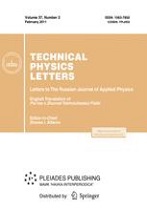|
This article is cited in 3 scientific papers (total in 3 papers)
Nonlinear regression algorithm for processing signals from semiconductor chemical sensors to provide selective detection of impurities in artificial air
V. V. Chistyakov, S. A. Kazakov, M. A. Grevtsev, S. M. Soloviev
Ioffe Institute, St. Petersburg
Abstract:
A new method has been developed for processing the signal of changes in electrical conductivity $\Delta\sigma$ under temperature $(T)$ modulation of a chemical sensor for the selective determination of trace concentrations of ammonia, acetone, n-hexane, propane, toluene, and other impurities in air. The method consists in the fact that, in the range of precisely set concentrations $C$ of each of impurities $Y$, the signal $\Delta\sigma$ as a function of reciprocal temperature $z=10^3/T$ is interpolated using nonlinear regression by a set of parameterized functions $F_i(z,A_i,b_i,c_i,\dots)$, $i$ = 1–4, and the dependences for principal (concentration) parameters $A_{iY}(C)$ are plotted, which determine the so-called “selectivity portrait” of $Y$. Fitting into it, similar values for detected impurity $X$ confirm its identity with $Y$, and the common abscissa of all intersection points $A_{iX}$ level lines with $A_{iY}(C)$ defines the numerical value and unit of measurement for the $C_X$ concentration.
Keywords:
chemical sensors, temperature modulation, selectivity, nonlinear regression, concentration, hydrocarbons, ammonia, acetone.
Received: 28.09.2020
Revised: 19.11.2020
Accepted: 01.12.2020
Citation:
V. V. Chistyakov, S. A. Kazakov, M. A. Grevtsev, S. M. Soloviev, “Nonlinear regression algorithm for processing signals from semiconductor chemical sensors to provide selective detection of impurities in artificial air”, Pisma v Zhurnal Tekhnicheskoi Fiziki, 47:6 (2021), 15–18; Tech. Phys. Lett., 47:3 (2021), 266–270
Linking options:
https://www.mathnet.ru/eng/pjtf4824 https://www.mathnet.ru/eng/pjtf/v47/i6/p15
|


| Statistics & downloads: |
| Abstract page: | 65 | | Full-text PDF : | 22 |
|





 Contact us:
Contact us: Terms of Use
Terms of Use
 Registration to the website
Registration to the website Logotypes
Logotypes








 Citation in format
Citation in format 
